ARMv7-M Architecture Reference Manual
Contents
List of Tables
List of Figures
Preface
About this manual
Using this manual
Part A, Application level architecture
Part B, system level architecture
Part C, debug architecture
Part D, appendices
Conventions
General typographic conventions
Further reading
ARM publications
Feedback
Feedback on this book
Application Level Architecture
Introduction
A1.1 The ARM Architecture – M profile
Application Level Programmers’ Model
A2.1 About the Application level programmers’ model
A2.1.1 Privileged execution
A2.1.2 System level architecture
A2.2 ARM core data types and arithmetic
A2.2.1 Integer arithmetic
Shift and rotate operations
Pseudocode details of addition and subtraction
Pseudocode details of saturation
A2.3 Registers and execution state
A2.3.1 ARM core registers
Pseudocode details of ARM core register operations
A2.3.2 The Application Program Status Register (APSR)
A2.3.3 Execution state support
A2.3.4 Privileged execution
A2.4 Exceptions, faults and interrupts
A2.4.1 System related events
A2.5 Coprocessor support
ARM Architecture Memory Model
A3.1 Address space
A3.1.1 Virtual versus physical addressing
A3.2 Alignment support
A3.2.1 Alignment behavior
Alignment and data access
Alignment and updates to the PC
A3.3 Endian support
A3.3.1 Control of the Endian Mapping in ARMv7-M
Instruction alignment and byte ordering
A3.3.2 Element size and Endianness
A3.3.3 Instructions to reverse bytes in a general-purpose register
A3.4 Synchronization and semaphores
A3.4.1 Exclusive access instructions and Non-shareable memory regions
A3.4.2 Exclusive access instructions and Shareable memory regions
Operation of the global monitor
A3.4.3 Tagging and the size of the tagged memory block
A3.4.4 Context switch support
A3.4.5 Load-Exclusive and Store-Exclusive usage restrictions
A3.4.6 Synchronization primitives and the memory order model
A3.5 Memory types and attributes and the memory order model
A3.5.1 Memory types
A3.5.2 Summary of ARMv7 memory attributes
A3.5.3 Atomicity in the ARM architecture
Single-copy atomicity
Multi-copy atomicity
A3.5.4 Normal memory
Non-shareable Normal memory
Shareable Normal memory
Write-Through cacheable, Write-Back cacheable and Non-cacheable Normal memory
A3.5.5 Device memory
Shareable attribute for Device memory regions
A3.5.6 Strongly-ordered memory
A3.5.7 Memory access restrictions
A3.6 Access rights
A3.6.1 Privilege level access controls for data accesses
A3.6.2 Privilege level access controls for instruction accesses
A3.7 Memory access order
A3.7.1 Reads and writes
Reads
Writes
Synchronization primitives
Observability and completion
A3.7.2 Ordering requirements for memory accesses
Program order for instruction execution
A3.7.3 Memory barriers
Data Memory Barrier (DMB)
Data Synchronization Barrier (DSB)
Instruction Synchronization Barrier (ISB)
A3.8 Caches and memory hierarchy
A3.8.1 Introduction to caches
A3.8.2 Implication of caches to the application programmer
A3.8.3 Preloading caches
The ARMv7-M Instruction Set
A4.1 About the instruction set
A4.1.1 ARMv7-M and interworking support
A4.1.2 Conditional execution
A4.2 Unified Assembler Language
A4.2.1 Conditional instructions
A4.2.2 Use of labels in UAL instruction syntax
A4.3 Branch instructions
A4.4 Data-processing instructions
A4.4.1 Standard data-processing instructions
A4.4.2 Shift instructions
A4.4.3 Multiply instructions
A4.4.4 Saturating instructions
A4.4.5 Packing and unpacking instructions
A4.4.6 Miscellaneous data-processing instructions
A4.4.7 Divide instructions
A4.5 Status register access instructions
A4.6 Load and store instructions
A4.6.1 Loads to the PC
A4.6.2 Halfword and byte loads and stores
A4.6.3 Unprivileged loads and stores
A4.6.4 Exclusive loads and stores
A4.6.5 Addressing modes
A4.7 Load/store multiple instructions
A4.7.1 Loads to the PC
A4.8 Miscellaneous instructions
A4.9 Exception-generating instructions
A4.10 Coprocessor instructions
Thumb Instruction Set Encoding
A5.1 Thumb instruction set encoding
A5.1.1 UNDEFINED and UNPREDICTABLE instruction set space
A5.1.2 Use of 0b1111 as a register specifier
A5.1.3 Use of 0b1101 as a register specifier
R13[1:0] definition
32-bit Thumb instruction support for R13
16-bit Thumb instruction support for R13
A5.2 16-bit Thumb instruction encoding
A5.2.1 Shift (immediate), add, subtract, move, and compare
A5.2.2 Data processing
A5.2.3 Special data instructions and branch and exchange
A5.2.4 Load/store single data item
A5.2.5 Miscellaneous 16-bit instructions
If-Then, and hints
A5.2.6 Conditional branch, and supervisor call
A5.3 32-bit Thumb instruction encoding
A5.3.1 Data processing (modified immediate)
A5.3.2 Modified immediate constants in Thumb instructions
Carry out
Operation
A5.3.3 Data processing (plain binary immediate)
A5.3.4 Branches and miscellaneous control
Hint instructions
Miscellaneous control instructions
A5.3.5 Load/store multiple
A5.3.6 Load/store dual or exclusive, table branch
A5.3.7 Load word
A5.3.8 Load halfword, unallocated memory hints
A5.3.9 Load byte, memory hints
A5.3.10 Store single data item
A5.3.11 Data processing (shifted register)
Move register and immediate shifts
A5.3.12 Data processing (register)
A5.3.13 Miscellaneous operations
A5.3.14 Multiply, and multiply accumulate
A5.3.15 Long multiply, long multiply accumulate, and divide
A5.3.16 Coprocessor instructions
Thumb Instruction Details
A6.1 Format of instruction descriptions
A6.1.1 Instruction section title
A6.1.2 Introduction to the instruction
A6.1.3 Instruction encodings
A6.1.4 Assembler syntax
Assembler syntax prototype line conventions
A6.1.5 Pseudocode describing how the instruction operates
A6.1.6 Exception information
A6.1.7 Notes
A6.2 Standard assembler syntax fields
A6.3 Conditional execution
A6.3.1 Pseudocode details of conditional execution
A6.3.2 Conditional execution of undefined instructions
A6.3.3 ITSTATE
Pseudocode details of ITSTATE operation
A6.4 Shifts applied to a register
A6.4.1 Constant shifts
Encoding
A6.4.2 Register controlled shifts
A6.4.3 Shift operations
A6.5 Memory accesses
A6.6 Hint Instructions
A6.6.1 Memory hints
A6.6.2 NOP-compatible hints
A6.7 Alphabetical list of ARMv7-M Thumb instructions
A6.7.1 ADC (immediate)
Assembler syntax
Operation
Exceptions
A6.7.2 ADC (register)
Assembler syntax
Operation
Exceptions
A6.7.3 ADD (immediate)
Assembler syntax
Operation
Exceptions
A6.7.4 ADD (register)
Assembler syntax
Operation
Exceptions
A6.7.5 ADD (SP plus immediate)
Assembler syntax
Operation
Exceptions
A6.7.6 ADD (SP plus register)
Assembler syntax
Operation
Exceptions
A6.7.7 ADR
Assembler syntax
Operation
Exceptions
A6.7.8 AND (immediate)
Assembler syntax
Operation
Exceptions
A6.7.9 AND (register)
Assembler syntax
Operation
Exceptions
A6.7.10 ASR (immediate)
Assembler syntax
Operation
Exceptions
A6.7.11 ASR (register)
Assembler syntax
Operation
Exceptions
A6.7.12 B
Assembler syntax
Operation
Exceptions
Related encodings
A6.7.13 BFC
Assembler syntax
Operation
Exceptions
A6.7.14 BFI
Assembler syntax
Operation
Exceptions
A6.7.15 BIC (immediate)
Assembler syntax
Operation
Exceptions
A6.7.16 BIC (register)
Assembler syntax
Operation
Exceptions
A6.7.17 BKPT
Assembler syntax
Operation
Exceptions
A6.7.18 BL
Assembler syntax
Operation
Exceptions
Note
A6.7.19 BLX (register)
Assembler syntax
Operation
Exceptions
A6.7.20 BX
Assembler syntax
Operation
Exceptions
A6.7.21 CBNZ, CBZ
Assembler syntax
Operation
Exceptions
A6.7.22 CDP, CDP2
Assembler syntax
Operation
Exceptions
Notes
A6.7.23 CLREX
Assembler syntax
Operation
Exceptions
A6.7.24 CLZ
Assembler syntax
Operation
Exceptions
A6.7.25 CMN (immediate)
Assembler syntax
Operation
Exceptions
A6.7.26 CMN (register)
Assembler syntax
Operation
Exceptions
A6.7.27 CMP (immediate)
Assembler syntax
Operation
Exceptions
A6.7.28 CMP (register)
Assembler syntax
Operation
Exceptions
A6.7.29 CPS
Note
A6.7.30 CPY
Assembler syntax
Exceptions
A6.7.31 DBG
Assembler syntax
Operation
Exceptions
A6.7.32 DMB
Assembler syntax
Operation
Exceptions
A6.7.33 DSB
Assembler syntax
Operation
Exceptions
A6.7.34 EOR (immediate)
Assembler syntax
Operation
Exceptions
A6.7.35 EOR (register)
Assembler syntax
Operation
Exceptions
A6.7.36 ISB
Assembler syntax
Operation
Exceptions
A6.7.37 IT
Assembler syntax
Operation
Exceptions
Related encodings
A6.7.38 LDC, LDC2 (immediate)
Assembler syntax
Operation
Exceptions
A6.7.39 LDC, LDC2 (literal)
Assembler syntax
Operation
Exceptions
A6.7.40 LDM / LDMIA / LDMFD
Assembler syntax
Operation
Exceptions
A6.7.41 LDMDB / LDMEA
Assembler syntax
Operation
Exceptions
A6.7.42 LDR (immediate)
Assembler syntax
Operation
Exceptions
A6.7.43 LDR (literal)
Assembler syntax
Operation
Exceptions
A6.7.44 LDR (register)
Assembler syntax
Operation
Exceptions
A6.7.45 LDRB (immediate)
Assembler syntax
Operation
Exceptions
A6.7.46 LDRB (literal)
Assembler syntax
Operation
Exceptions
A6.7.47 LDRB (register)
Assembler syntax
Operation
Exceptions
A6.7.48 LDRBT
Assembler syntax
Operation
Exceptions
A6.7.49 LDRD (immediate)
Assembler syntax
Operation
Exceptions
A6.7.50 LDRD (literal)
Assembler syntax
Operation
Exceptions
A6.7.51 LDREX
Assembler syntax
Operation
Exceptions
A6.7.52 LDREXB
Assembler syntax
Operation
Exceptions
A6.7.53 LDREXH
Assembler syntax
Operation
Exceptions
A6.7.54 LDRH (immediate)
Assembler syntax
Operation
Exceptions
Unallocated memory hints
A6.7.55 LDRH (literal)
Assembler syntax
Operation
Exceptions
A6.7.56 LDRH (register)
Assembler syntax
Operation
Exceptions
A6.7.57 LDRHT
Assembler syntax
Operation
Exceptions
A6.7.58 LDRSB (immediate)
Assembler syntax
Operation
Exceptions
A6.7.59 LDRSB (literal)
Assembler syntax
Operation
Exceptions
A6.7.60 LDRSB (register)
Assembler syntax
Operation
Exceptions
A6.7.61 LDRSBT
Assembler syntax
Operation
Exceptions
A6.7.62 LDRSH (immediate)
Assembler syntax
Operation
Exceptions
A6.7.63 LDRSH (literal)
Assembler syntax
Operation
Exceptions
Unallocated memory hints
A6.7.64 LDRSH (register)
Assembler syntax
Operation
Exceptions
A6.7.65 LDRSHT
Assembler syntax
Operation
Exceptions
A6.7.66 LDRT
Assembler syntax
Operation
Exceptions
A6.7.67 LSL (immediate)
Assembler syntax
Operation
Exceptions
A6.7.68 LSL (register)
Assembler syntax
Operation
Exceptions
A6.7.69 LSR (immediate)
Assembler syntax
Operation
Exceptions
A6.7.70 LSR (register)
Assembler syntax
Operation
Exceptions
A6.7.71 MCR, MCR2
Assembler syntax
Operation
Exceptions
Notes
A6.7.72 MCRR, MCRR2
Assembler syntax
Operation
Exceptions
A6.7.73 MLA
Assembler syntax
Operation
Exceptions
A6.7.74 MLS
Assembler syntax
Operation
Exceptions
A6.7.75 MOV (immediate)
Assembler syntax
Operation
Exceptions
A6.7.76 MOV (register)
Assembler syntax
Operation
Exceptions
A6.7.77 MOV (shifted register)
Assembler syntax
Exceptions
A6.7.78 MOVT
Assembler syntax
Operation
Exceptions
A6.7.79 MRC, MRC2
Assembler syntax
Operation
Exceptions
A6.7.80 MRRC, MRRC2
Assembler syntax
Operation
Exceptions
A6.7.81 MRS
Note
A6.7.82 MSR (register)
Note
A6.7.83 MUL
Assembler syntax
Operation
Exceptions
A6.7.84 MVN (immediate)
Assembler syntax
Operation
Exceptions
A6.7.85 MVN (register)
Assembler syntax
Operation
Exceptions
A6.7.86 NEG
Assembler syntax
Exceptions
A6.7.87 NOP
Assembler syntax
Operation
Exceptions
A6.7.88 ORN (immediate)
Assembler syntax
Operation
Exceptions
A6.7.89 ORN (register)
Assembler syntax
Operation
Exceptions
A6.7.90 ORR (immediate)
Assembler syntax
Operation
Exceptions
A6.7.91 ORR (register)
Assembler syntax
Operation
Exceptions
A6.7.92 PLD, PLDW (immediate)
Assembler syntax
Operation
Exceptions
A6.7.93 PLD (literal)
Assembler syntax
Operation
Exceptions
A6.7.94 PLD (register)
Assembler syntax
Operation
Exceptions
A6.7.95 PLI (immediate, literal)
Assembler syntax
Operation
Exceptions
A6.7.96 PLI (register)
Assembler syntax
Operation
Exceptions
A6.7.97 POP
Assembler syntax
Operation
Exceptions
A6.7.98 PUSH
Assembler syntax
Operation
Exceptions
A6.7.99 RBIT
Assembler syntax
Operation
Exceptions
A6.7.100 REV
Assembler syntax
Operation
Exceptions
A6.7.101 REV16
Assembler syntax
Operation
Exceptions
A6.7.102 REVSH
Assembler syntax
Operation
Exceptions
A6.7.103 ROR (immediate)
Assembler syntax
Operation
Exceptions
A6.7.104 ROR (register)
Assembler syntax
Operation
Exceptions
A6.7.105 RRX
Assembler syntax
Operation
Exceptions
A6.7.106 RSB (immediate)
Assembler syntax
Operation
Exceptions
A6.7.107 RSB (register)
Assembler syntax
Operation
Exceptions
A6.7.108 SBC (immediate)
Assembler syntax
Operation
Exceptions
A6.7.109 SBC (register)
Assembler syntax
Operation
Exceptions
A6.7.110 SBFX
Assembler syntax
Operation
Exceptions
A6.7.111 SDIV
Assembler syntax
Operation
Exceptions
Notes
A6.7.112 SEV
Assembler syntax
Operation
Exceptions
A6.7.113 SMLAL
Assembler syntax
Operation
Exceptions
A6.7.114 SMULL
Assembler syntax
Operation
Exceptions
A6.7.115 SSAT
Assembler syntax
Operation
Exceptions
A6.7.116 STC, STC2
Assembler syntax
Operation
Exceptions
A6.7.117 STM / STMIA / STMEA
Assembler syntax
Operation
Exceptions
A6.7.118 STMDB / STMFD
Assembler syntax
Operation
Exceptions
A6.7.119 STR (immediate)
Assembler syntax
Operation
Exceptions
A6.7.120 STR (register)
Assembler syntax
Operation
Exceptions
A6.7.121 STRB (immediate)
Assembler syntax
Operation
Exceptions
A6.7.122 STRB (register)
Assembler syntax
Operation
Exceptions
A6.7.123 STRBT
Assembler syntax
Operation
Exceptions
A6.7.124 STRD (immediate)
Assembler syntax
Operation
Exceptions
A6.7.125 STREX
Assembler syntax
Operation
Exceptions
A6.7.126 STREXB
Assembler syntax
Operation
Exceptions
A6.7.127 STREXH
Assembler syntax
Operation
Exceptions
A6.7.128 STRH (immediate)
Assembler syntax
Operation
Exceptions
A6.7.129 STRH (register)
Assembler syntax
Operation
Exceptions
A6.7.130 STRHT
Assembler syntax
Operation
Exceptions
A6.7.131 STRT
Assembler syntax
Operation
Exceptions
A6.7.132 SUB (immediate)
Assembler syntax
Operation
Exceptions
A6.7.133 SUB (register)
Assembler syntax
Operation
Exceptions
A6.7.134 SUB (SP minus immediate)
Assembler syntax
Operation
Exceptions
A6.7.135 SUB (SP minus register)
Assembler syntax
Operation
Exceptions
A6.7.136 SVC (formerly SWI)
Assembler syntax
Operation
Exceptions
A6.7.137 SXTB
Assembler syntax
Operation
Exceptions
A6.7.138 SXTH
Assembler syntax
Operation
Exceptions
A6.7.139 TBB, TBH
Assembler syntax
Operation
Exceptions
A6.7.140 TEQ (immediate)
Assembler syntax
Operation
Exceptions
A6.7.141 TEQ (register)
Assembler syntax
Operation
Exceptions
A6.7.142 TST (immediate)
Assembler syntax
Operation
Exceptions
A6.7.143 TST (register)
Assembler syntax
Operation
Exceptions
A6.7.144 UBFX
Assembler syntax
Operation
Exceptions
A6.7.145 UDIV
Assembler syntax
Operation
Exceptions
A6.7.146 UMLAL
Assembler syntax
Operation
Exceptions
A6.7.147 UMULL
Assembler syntax
Operation
Exceptions
A6.7.148 USAT
Assembler syntax
Operation
Exceptions
A6.7.149 UXTB
Assembler syntax
Operation
Exceptions
A6.7.150 UXTH
Assembler syntax
Operation
Exceptions
A6.7.151 WFE
Assembler syntax
Operation
Exceptions
A6.7.152 WFI
Assembler syntax
Operation
Exceptions
Notes
A6.7.153 YIELD
Assembler syntax
Operation
Exceptions
System Level Architecture
System Level Programmers’ Model
B1.1 Introduction to the system level
B1.2 ARMv7-M: a memory mapped architecture
B1.3 System level operation and terminology overview
B1.3.1 Modes, Privilege and Stacks
B1.3.2 Exceptions
Priority Levels and Execution Pre-emption
Exception Return
B1.3.3 Execution State
B1.3.4 Debug State
B1.4 Registers
B1.4.1 The SP registers
B1.4.2 The special-purpose program status registers (xPSR)
B1.4.3 The special-purpose mask registers
B1.4.4 The special-purpose control register
B1.4.5 Reserved special-purpose register bits
B1.4.6 Special-purpose register updates and the memory order model
B1.4.7 Register related definitions for pseudocode
Pseudocode details for ARM core register access in the Thumb instruction set
B1.5 Exception model
B1.5.1 Overview of the exceptions supported
B1.5.2 Exception number definition
B1.5.3 The vector table
B1.5.4 Exception priorities and pre-emption
Priority grouping
Execution priority and priority boosting within the core
Priority escalation
SVCall, PendSV and critical region code avoidance
B1.5.5 Reset behavior
B1.5.6 Exception entry behavior
B1.5.7 Stack alignment on exception entry
Theory of operation
Compatibility
B1.5.8 Exception return behavior
Integrity checks on exception returns
Exception return operation
B1.5.9 Exceptions in single-word load operations
B1.5.10 Exceptions in LDM and STM operations
Load multiple and PC in load list
Load-store multiple, base register update and the ICI bits
B1.5.11 Exceptions on exception entry
Late arriving exceptions
Derived exceptions
B1.5.12 Tail-chaining and exceptions on exception return
Derived exceptions
Tail-chaining
Use of tail-chaining as an optimization for pending exceptions
Late arrival pre-emption and tail-chaining during exception returns
B1.5.13 Exception status and control
B1.5.14 Fault behavior
Fault status and address information
B1.5.15 Unrecoverable exception cases
B1.5.16 Reset management
Reset and debug
B1.5.17 Power management
B1.5.18 Wait For Event and Send Event
WFE wake-up events
The Event Register
The Send Event instruction
The Wait For Event instruction
Pseudocode details of the Wait For Event lock mechanism
B1.5.19 Wait For Interrupt
Using WFI to indicate an idle state on bus interfaces
Pseudocode details of Wait For Interrupt
System Memory Model
B2.1 Introduction
B2.2 Pseudocode details of general memory system operations
B2.2.1 Memory data type definitions
B2.2.2 Basic memory accesses
B2.2.3 Interfaces to memory system specific pseudocode
B2.2.4 Aligned memory accesses
B2.2.5 Unaligned memory accesses
B2.2.6 Reverse endianness
B2.2.7 Pseudocode details of operations on exclusive monitors
B2.2.8 Access permission checking
B2.2.9 MPU access control decode
B2.2.10 Default memory access decode
B2.2.11 MemManage fault handling
System Address Map
B3.1 The system address map
B3.1.1 General rules applying to PPB register access
B3.2 System Control Space (SCS)
B3.2.1 System control and ID blocks
The Interrupt Controller Type Register (ICTR)
The Auxiliary Control Register (ACTLR)
B3.2.2 System ID register support in the SCS
CPU attribute ID registers
B3.2.3 The System Control Block (SCB)
Interrupt Control State Register (ICSR)
Vector Table Offset Register (VTOR)
Application Interrupt and Reset Control Register (AIRCR)
System Control Register (SCR)
Configuration and Control Register (CCR)
System Handler Priority Register 1 (SHPR1)
System Handler Priority Register 2 (SHPR2)
System Handler Priority Register 3 (SHPR3)
System Handler Control and State Register (SHCSR)
Configurable Fault Status Registers (UserFault, BusFault, and MemManage)
HardFault Status register (HFSR)
Debug Fault Status Register (DFSR)
Auxiliary Fault Status Register (AFSR)
MemManage Address Register (MMFAR)
BusFault Address Register (BFAR)
Coprocessor Access Control Register (CPACR)
Software Trigger Interrupt Register (STIR)
B3.3 System timer - SysTick
B3.3.1 Theory of operation
B3.3.2 System timer register support in the SCS
SysTick Control and Status Register (SYST_CSR)
SysTick Reload Value Register (SYST_RVR)
SysTick Current Value Register (SYST_CVR)
SysTick Calibration value Register (SYST_CALIB)
B3.4 Nested Vectored Interrupt Controller (NVIC)
B3.4.1 Theory of operation
External interrupt input behavior
B3.4.2 NVIC register support in the SCS
Interrupt Controller Type Register (ICTR)
Interrupt Set-Enable and Clear-Enable Registers (NVIC_ISERx and NVIC_ICERx)
Interrupt Set-Pending and Clear-Pending Registers (NVIC_ISPRx and NVIC_ICPRx)
Active Bit Register (NVIC_IABRx)
Interrupt Priority Register (NVIC_IPRx)
B3.5 Protected Memory System Architecture (PMSAv7)
B3.5.1 PMSAv7 compliant MPU operation
Sub-region support
ARMv7-M specific support
MPU pseudocode
MPU fault support
B3.5.2 Register support for PMSAv7 in the SCS
MPU Type Register (MPU_TYPE)
MPU Control Register (MPU_CTRL)
MPU Region Number Register (MPU_RNR)
MPU Region Base Address Register (MPU_RBAR)
MPU Region Attribute and Size Register (MPU_RASR)
MPU alias register support
ARMv7-M System Instructions
B4.1 Alphabetical list of ARMv7-M system instructions
B4.1.1 CPS
Assembler syntax
Operation
Exceptions
Notes
B4.1.2 MRS
Assembler syntax
Operation
Exceptions
Notes
B4.1.3 MSR (register)
Assembler syntax
Operation
Exceptions
Notes
Debug Architecture
ARMv7-M Debug
C1.1 Introduction to debug
C1.2 The Debug Access Port (DAP)
C1.2.1 General rules applying to debug register access
C1.3 Overview of the ARMv7-M debug features
C1.3.1 Debug authentication
C1.3.2 External debug request
C1.3.3 External restart request
DBGRESTART and DBGRESTARTED
C1.3.4 Debug support in ARMv7-M
Recommended levels of debug
C1.4 Debug and reset
C1.5 Debug event behavior
C1.5.1 Debug stepping
Debug monitor stepping
C1.6 Debug register support in the SCS
C1.6.1 Debug Fault Status Register (DFSR)
C1.6.2 Debug Halting Control and Status Register (DHCSR)
C1.6.3 Debug Core Register Selector Register (DCRSR)
C1.6.4 Debug Core Register Data Register (DCRDR)
C1.6.5 Debug Exception and Monitor Control Register (DEMCR)
Vector catch support
C1.7 Instrumentation Trace Macrocell (ITM) support
C1.7.1 Theory of operation
Timestamp support
Synchronization support
C1.7.2 Register support for the ITM
Stimulus Portx Register - ITM_STIM[255:0] (0xE0000000 to 0xE00003FC)
Trace Enable Register - ITM_TER[7:0] (0xE0000E00 to 0xE0000E1C)
Trace Privilege Register - ITM_TPR (0xE0000E40)
Trace Control Register – ITM_TCR (0xE0000E80)
C1.8 Data Watchpoint and Trace (DWT) support
C1.8.1 Theory of operation
Exception trace support
Cycle counter and PC sampling support
Profiling counter support
Profiling counter accuracy
Program counter sampling support
Comparator support
LinkAddr() support
Comparator support - cycle count matching
Comparator support - instruction address matching
Comparator support - data address matching
Comparator support - watchpoint data value matching
C1.8.2 Register support for the DWT
Control Register (DWT_CTRL)
Cycle Count Register (DWT_CYCCNT)
CPI Count Register (DWT_CPICNT)
Exception Overhead Count Register (DWT_EXCCNT)
Sleep Count Register (DWT_SLEEPCNT)
LSU Count Register (DWT_LSUCNT)
Folded-instruction Count Register (DWT_FOLDCNT)
Program Counter Sample Register (DWT_PCSR)
Comparator Register (DWT_COMPx)
Mask Register (DWT_MASKx)
Function Register (DWT_FUNCTIONx)
C1.9 Embedded Trace (ETM) support
C1.10 Trace Port Interface Unit (TPIU)
C1.10.1 The TPIU Programmers’ Model
Supported Synchronous Port Sizes Register (TPIU_SSPSR, 0xE0040000)
Current Synchronous Port Size Register (TPIU_CSPSR, 0xE0040004)
Asynchronous Clock Prescaler Register (TPIU_ACPR, 0xE0040010)
Selected Pin Protocol Register (TPIU_SPPR, 0xE00400F0)
TPIU Type Register (TPIU_TYPE, 0xE0040FC8)
C1.11 Flash Patch and Breakpoint (FPB) support
C1.11.1 Theory of operation
C1.11.2 Register support for the FPB
FlashPatch Control Register (FP_CTRL)
FlashPatch Remap Register (FP_REMAP)
FlashPatch Comparator Register – instruction comparison (FP_COMPx)
FlashPatch Comparator Register – literal comparison (FP_COMPx)
Appendices
CPUID
A.1 Core Feature ID Registers
A.1.1 Convention for CPUID attribute descriptions
A.2 Processor Feature register0 (ID_PFR0)
A.3 Processor Feature register1 (ID_PFR1)
A.4 Debug Features register0 (ID_DFR0)
A.5 Auxiliary Features register0 (ID_AFR0)
A.6 Memory Model Feature registers
A.6.1 Memory Model Feature register0 (ID_MMFR0)
A.6.2 Memory Model Feature register1 (ID_MMFR1)
A.6.3 Memory Model Feature register2 (ID_MMFR2)
A.6.4 Memory Model Feature register3 (ID_MMFR3)
A.7 Instruction Set Attribute registers – background information
A.7.1 The basic instruction set
A.7.2 General rules
A.7.3 Q flag support
A.7.4 MOV instructions
A.7.5 Non-MOV data-processing instructions
A.7.6 Multiply instructions
A.7.7 Branches
A.7.8 Load/store single instructions
A.7.9 Load/store multiple instructions
A.8 Instruction Set Attribute registers – details
A.8.1 Instruction Set Attributes Register0 (ID_ISAR0)
A.8.2 Instruction Set Attributes Register1 (ID_ISAR1)
A.8.3 Instruction Set Attributes Register2 (ID_ISAR2)
A.8.4 Instruction Set Attributes Register3 (ID_ISAR3)
A.8.5 Instruction Set Attributes Register3 (ID_ISAR4)
ARMv7-M infrastructure IDs
Legacy Instruction Mnemonics
C.1 Thumb instruction mnemonics
C.2 Pre-UAL pseudo-instruction NOP
Deprecated Features in ARMv7-M
Debug ITM and DWT packet protocol
E.1 Packet Types
E.1.1 Sync Packet
E.1.2 Overflow Packet
E.1.3 Timestamp Packet
E.1.4 Software Instrumentation Packet
E.1.5 Hardware Source Packet
E.1.6 Extension Packets
E.1.7 Reserved Encodings
E.1.8 Multiple Source Arbitration
E.2 DWT packet formats
E.2.1 Event Packets – Discriminator ID0
E.2.2 Exception Trace Packets – Discriminator ID1
E.2.3 PC Sample Packets – Discriminator ID2
E.2.4 Data Trace (Watchpoint) Packets – Discriminator ID8 to ID23
Packet format - data trace PC sampling
Packet format - data trace address offset
ARMv7-R differences
F.1 Endian support
F.2 Application level support
F.3 System level support
F.4 Debug support
Pseudocode definition
G.1 Instruction encoding diagrams and pseudocode
G.1.1 Pseudocode
G.2 Limitations of pseudocode
G.3 Data Types
G.3.1 General data type rules
G.3.2 Bitstrings
G.3.3 Integers
G.3.4 Reals
G.3.5 Booleans
G.3.6 Enumerations
G.3.7 Lists
G.3.8 Arrays
G.4 Expressions
G.4.1 General expression syntax
G.4.2 Operators and functions - polymorphism and prototypes
G.4.3 Precedence rules
G.5 Operators and built-in functions
G.5.1 Operations on generic types
Equality and non-equality testing
Conditional selection
G.5.2 Operations on booleans
G.5.3 Bitstring manipulation
Bitstring length and top bit
Bitstring concatenation and replication
Bitstring extraction
Logical operations on bitstrings
Bitstring count
Testing a bitstring for being all zero or all ones
Lowest and highest set bits of a bitstring
Zero-extension and sign-extension of bitstrings
Converting bitstrings to integers
G.5.4 Arithmetic
Unary plus, minus and absolute value
Addition and subtraction
Comparisons
Multiplication
Division and modulo
Square Root
Rounding and aligning
Scaling
Maximum and minimum
G.6 Statements and program structure
G.6.1 Simple statements
Assignments
Procedure calls
Return statements
UNDEFINED
UNPREDICTABLE
SEE...
IMPLEMENTATION_DEFINED
SUBARCHITECTURE_DEFINED
G.6.2 Compound statements
if ... then ... else ...
repeat ... until ...
while ... do
for ...
case ... of ...
Procedure and function definitions
G.6.3 Comments
G.7 Miscellaneous helper procedures and functions
G.7.1 ArchVersion()
G.7.2 BadReg()
G.7.3 BreakPoint()
G.7.4 CallSupervisor()
G.7.5 ConditionPassed()
G.7.6 Coproc_Accepted()
G.7.7 Coproc_DoneLoading()
G.7.8 Coproc_DoneStoring()
G.7.9 Coproc_GetOneWord()
G.7.10 Coproc_GetTwoWords()
G.7.11 Coproc_GetWordToStore()
G.7.12 Coproc_InternalOperation()
G.7.13 Coproc_SendLoadedWord()
G.7.14 Coproc_SendOneWord()
G.7.15 Coproc_SendTwoWords()
G.7.16 DataMemoryBarrier()
G.7.17 DataSynchronizationBarrier()
G.7.18 EncodingSpecificOperations()
G.7.19 GenerateCoprocessorException()
G.7.20 GenerateIntegerZeroDivide()
G.7.21 Hint_Debug()
G.7.22 Hint_PreloadData()
G.7.23 Hint_PreloadDataForWrite()
G.7.24 Hint_PreloadInstr()
G.7.25 Hint_SendEvent()
G.7.26 Hint_Yield()
G.7.27 InstructionSynchronizationBarrier()
G.7.28 IntegerZeroDivideTrappingEnabled()
G.7.29 ProcessorID()
G.7.30 SetPending()
G.7.31 ThisInstr()
Pseudocode Index
H.1 Pseudocode operators and keywords
H.2 Pseudocode functions and procedures
Register Index
I.1 ARM core registers
I.2 Memory mapped system registers
I.3 Memory mapped debug registers
Glossary

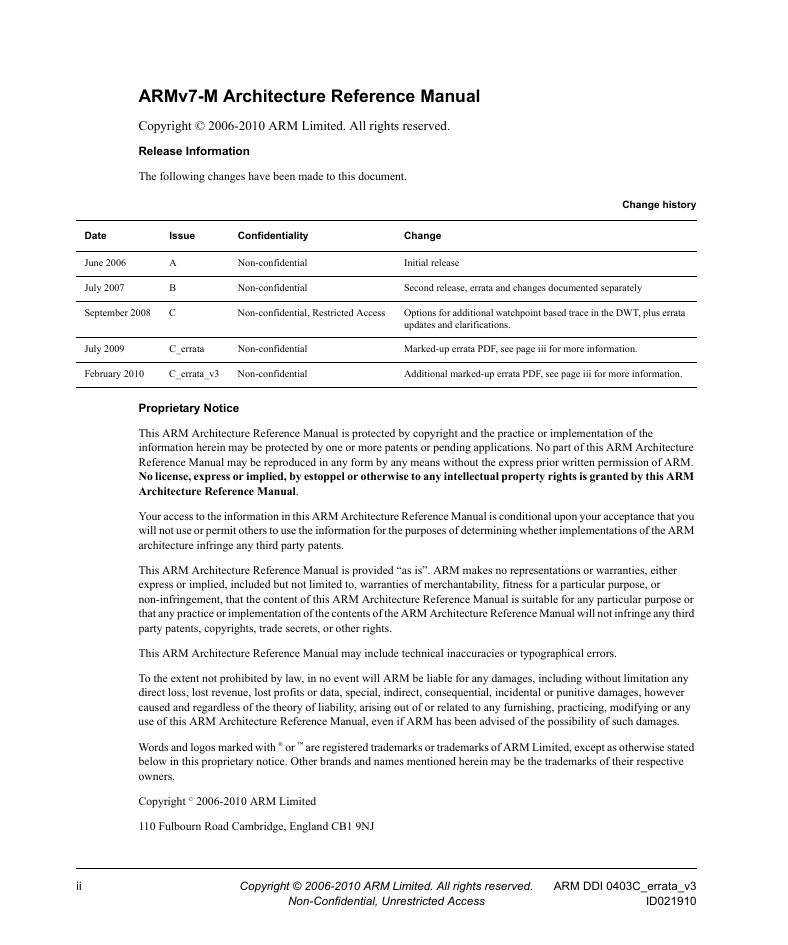


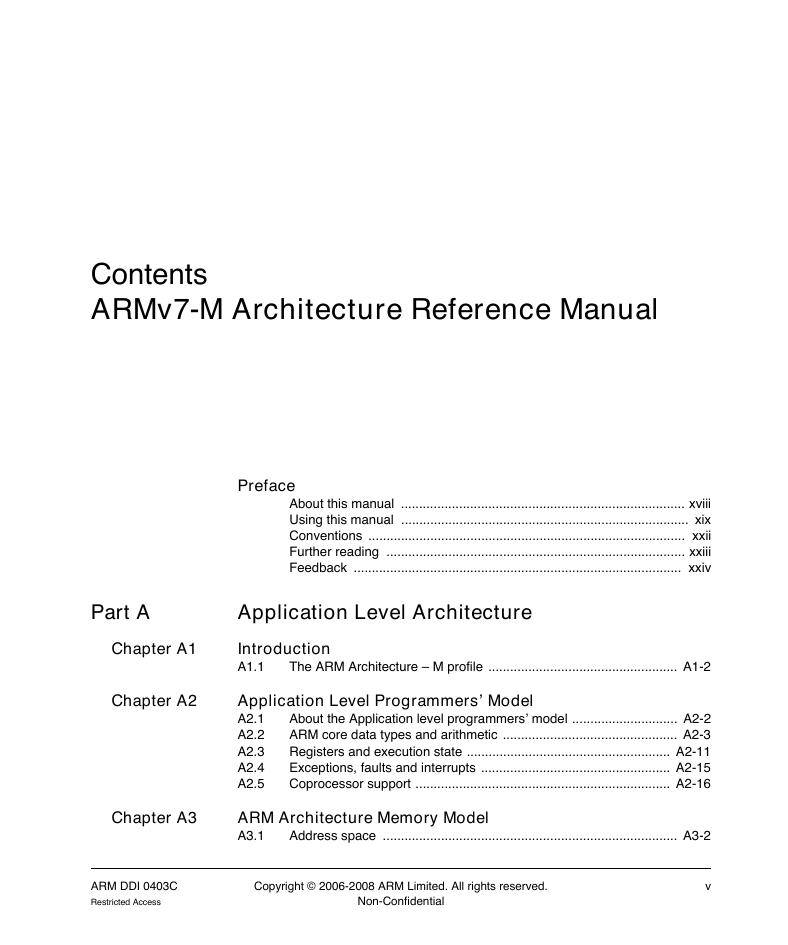
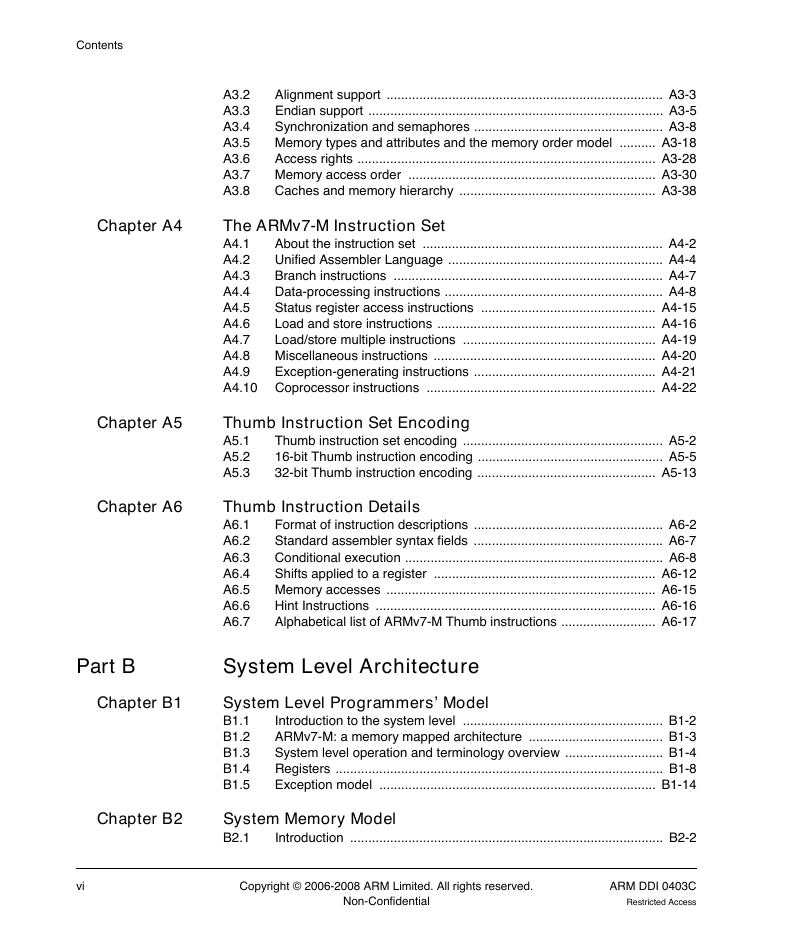
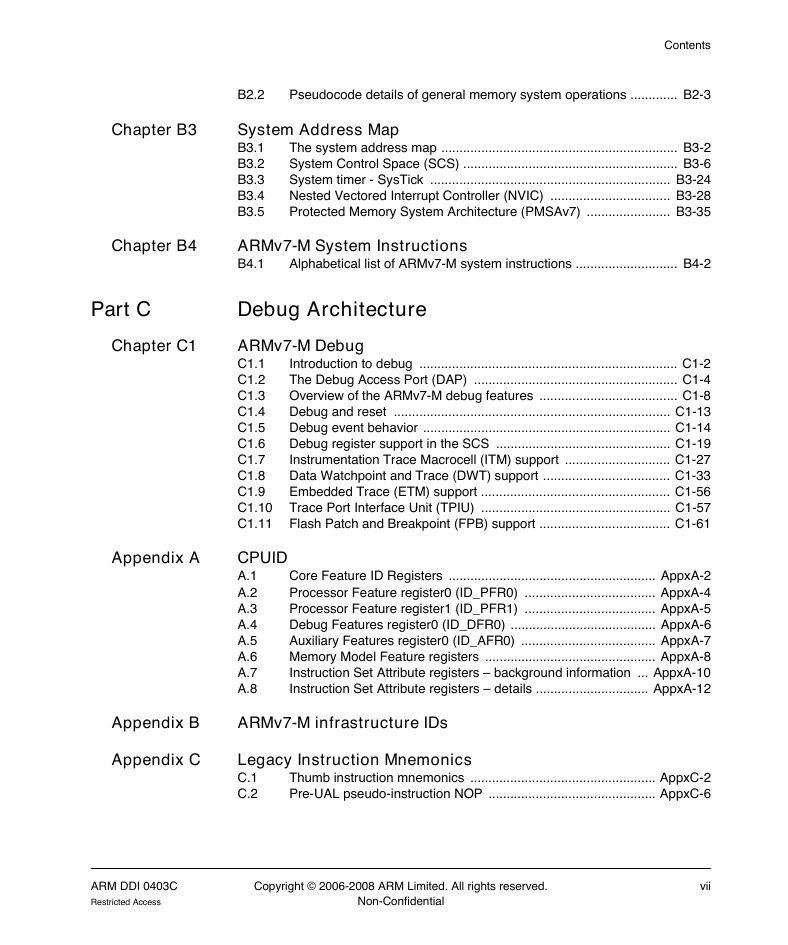
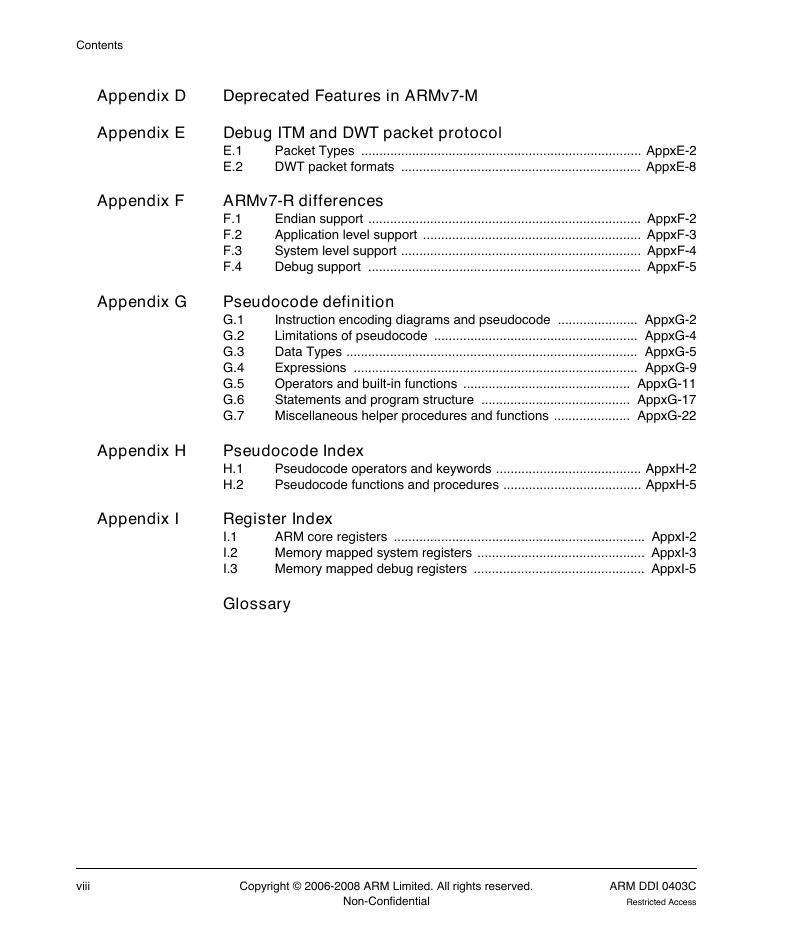








 2023年江西萍乡中考道德与法治真题及答案.doc
2023年江西萍乡中考道德与法治真题及答案.doc 2012年重庆南川中考生物真题及答案.doc
2012年重庆南川中考生物真题及答案.doc 2013年江西师范大学地理学综合及文艺理论基础考研真题.doc
2013年江西师范大学地理学综合及文艺理论基础考研真题.doc 2020年四川甘孜小升初语文真题及答案I卷.doc
2020年四川甘孜小升初语文真题及答案I卷.doc 2020年注册岩土工程师专业基础考试真题及答案.doc
2020年注册岩土工程师专业基础考试真题及答案.doc 2023-2024学年福建省厦门市九年级上学期数学月考试题及答案.doc
2023-2024学年福建省厦门市九年级上学期数学月考试题及答案.doc 2021-2022学年辽宁省沈阳市大东区九年级上学期语文期末试题及答案.doc
2021-2022学年辽宁省沈阳市大东区九年级上学期语文期末试题及答案.doc 2022-2023学年北京东城区初三第一学期物理期末试卷及答案.doc
2022-2023学年北京东城区初三第一学期物理期末试卷及答案.doc 2018上半年江西教师资格初中地理学科知识与教学能力真题及答案.doc
2018上半年江西教师资格初中地理学科知识与教学能力真题及答案.doc 2012年河北国家公务员申论考试真题及答案-省级.doc
2012年河北国家公务员申论考试真题及答案-省级.doc 2020-2021学年江苏省扬州市江都区邵樊片九年级上学期数学第一次质量检测试题及答案.doc
2020-2021学年江苏省扬州市江都区邵樊片九年级上学期数学第一次质量检测试题及答案.doc 2022下半年黑龙江教师资格证中学综合素质真题及答案.doc
2022下半年黑龙江教师资格证中学综合素质真题及答案.doc